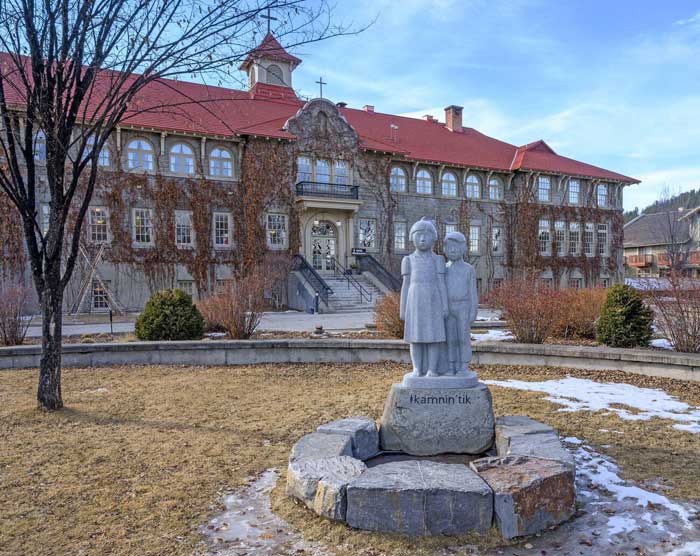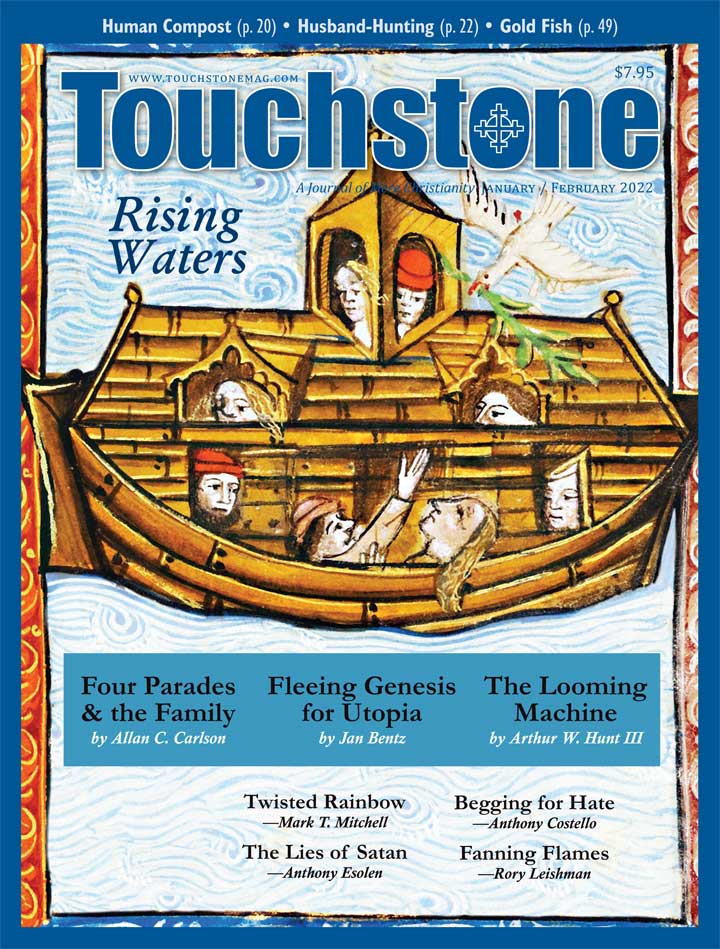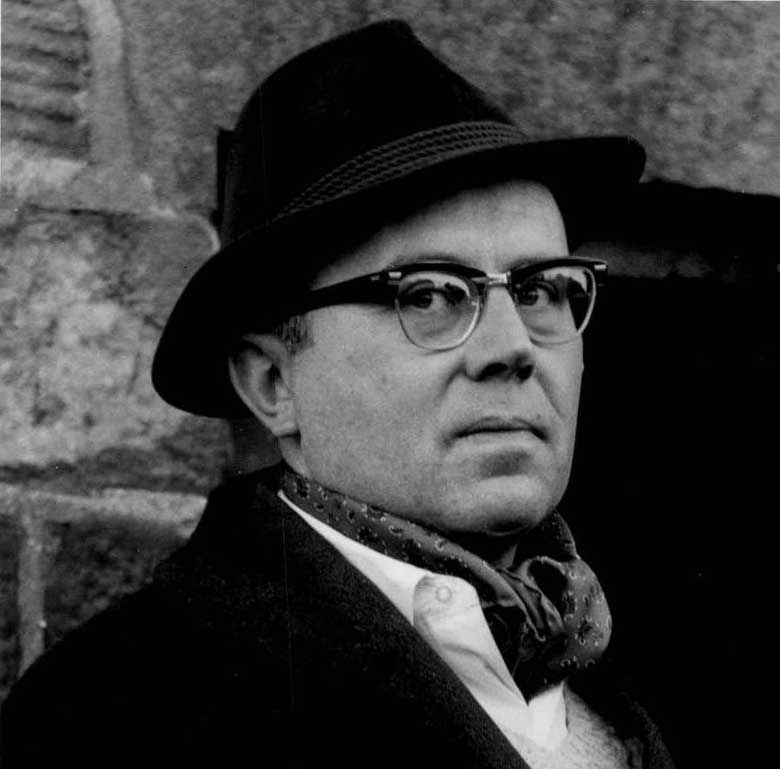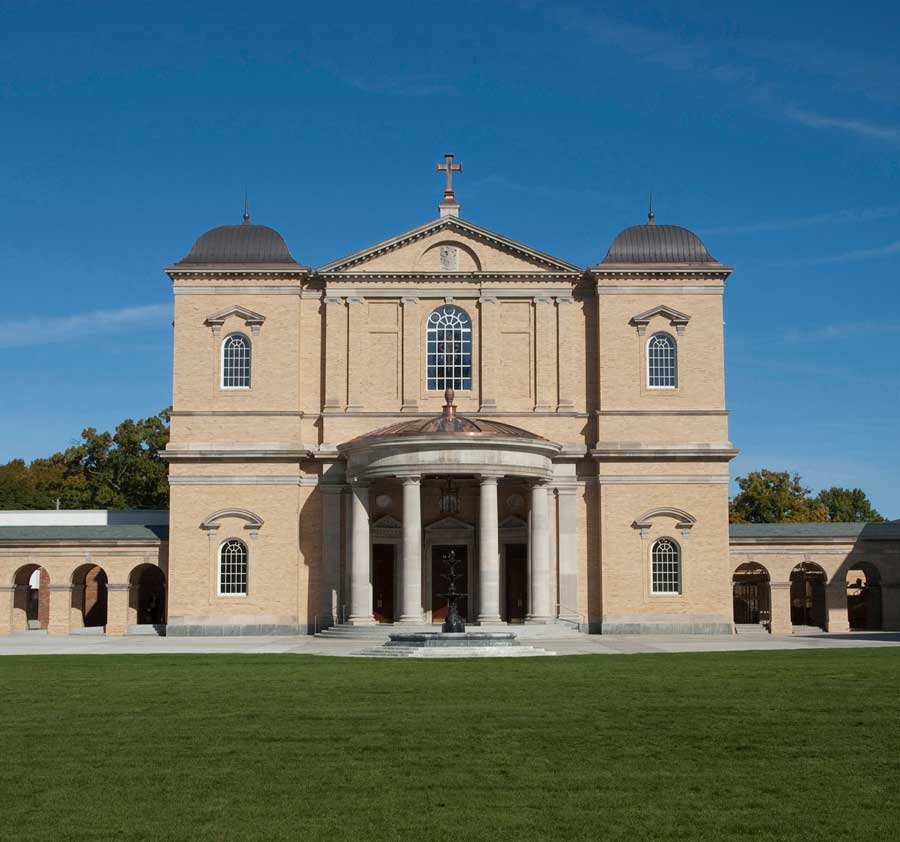Fanning the Flames
The Sources of Canadian
Anti-Christian Rage
by Rory Leishman
Since the announcement on May 27, 2021, that a researcher using ground-penetrating radar had discovered an estimated 251 unmarked graves on the grounds of a former Indian Residential School near Kamloops, British Columbia, seven churches in Canada, all but one of them on First Nations lands, have been burned down in suspicious fires. Enraged vandals are also believed to have set fire to at least twelve other Canadian churches and to have desecrated dozens more with red and orange paint.
Who is responsible for this unprecedented outburst of anti-Christian rage in a country hitherto renowned for its commitment to peace, order, and good government? Canadian Prime Minister Justin Trudeau pins much of the blame on the Catholic and Protestant agencies that ran the Indian Residential Schools (IRS) on behalf of the Canadian government between 1883 and 1996. In a statement on July 2, Trudeau said that vandalism and arson could not be justified, but "I understand the anger that's out there against the federal government, against institutions like the Catholic Church. It is real and it's fully understandable, given the shameful history that we are all becoming more and more aware of."
Is he right? Are Canadians becoming more aware of the history of the Indian Residential Schools that were variously run by Catholic and Protestant churches across Canada for over a century? Sadly, they are not. And that is largely because, for the past two decades, progressive politicians like Trudeau and his counterparts in the mass media have misled Canadians with false accounts of murder and mayhem in the IRS system.
Extreme Allegations
On June 24, for example, the Canadian Broadcasting Corporation (CBC) began its morning newscast World Report with a frenzied accusation: "What happened? What led to those children being murdered? And let's be blunt about it: They were murdered." CBC producer Blake Prendergast then explained that the person making this shocking accusation was Wayne Semaganis, Chief of Little Pine First Nation in Saskatchewan, and that he was reacting to news about the discovery of about 750 unmarked graves in a cemetery at the site of the former Marieval Indian Residential School, operated by the Catholic Church on the Cowessess Reserve in Saskatchewan. Prendergast added, "After almost one hundred years of operation, the building has been torn down, but the horrors of what happened there have not been forgotten."
On August 10, the CBC followed up with a similar segment in its evening broadcast, The World at Six, this time featuring RoseAnne Archibald, National Chief of the Assembly of First Nations. She told the CBC, "For decades, we were not believed. Our survivors were not believed." She then said, "Make no mistake: We are seeing evidence of genocide." CBC reporter Raffi Boudjikian observed that the Canadian government had to that point "sidestepped" using the word "genocide."
On June 23, the Toronto Globe & Mail broadcast some equally extreme allegations against Christian IRS care-givers by Bobby Cameron, Chief of the Federation of Sovereign Indigenous Nations in Saskatchewan. "We will do a search of every Indian Residential School site and we won't stop there," Cameron avowed.
We will also search all of the sanatoriums, Indian hospitals and all the sites where people were taken and abused, tortured, neglected and murdered. We will tell the stories of our children, of our people who died. Who were killed by the state, by the churches, and we won't stop until we locate all of them. The world is watching as we unearth the findings of genocide.
Other mainstream newspapers and broadcasters in Canada made similar allegations against Christian teachers and supervisors in the IRS system. Yet all of these dreadful allegations have gone entirely uncorroborated.
Failures of the Truth & Reconciliation Commission
Back in 2008, a special Truth and Reconciliation Commission (TRC) was set up by the Canadian government to "promote awareness and public education of Canadians about the IRS system and its impacts." The TRC's chair, the Honorable Murray Sinclair, is a much-honored member of the Peguis First Nation in Manitoba, a former associate chief judge of the Provincial Court of Manitoba, and a former member of the Canadian Senate. More recently, he was sworn in as the Chancellor of Queen's University in Kingston, Ontario.
On June 27, the U.K. Guardian quoted Sinclair as stating that during thousands of hours of testimony by former IRS students, he and his colleagues on the TRC
heard stories from survivors who witnessed children being put to death, particularly infants born in the schools who had been fathered by a priest. . . . Many survivors told us that they witnessed those children, those infants, being either buried alive or killed—and sometimes being thrown into furnaces.
"Those stories," Sinclair concluded, "need to be checked out."
Indeed they do. But why did Sinclair not have the TRC itself do so? Why did he peddle such lurid accounts of murderous abuse when none of them had been corroborated? And why did the Canadian media also publish such horrendous allegations without offering any supportive evidence?
The Final Report of the TRC was published in 2015. It included the testimony of Doris Young, a former student at an IRS in Elkhorn, Manitoba, which was operated by the Anglican Church of Canada. Young said:
I remember . . . there was [sic] all these screams, and there was blood over the, the walls. [Crying] . . . and we were told that if we, if we were, if we ever told, or tried to run away, we would, the same thing would happen to us. [Crying] So it was a dangerous time for, for children, and for me at that, those days. [Crying] We really never knew who would be next to be murdered. . . .
Young reportedly had nightmares about this atrocity for years and "eventually reported the incident to the police as an adult." But although "the RCMP investigated," Young testified, "they said they couldn't find anything."
Of course, it is possible that Young suffered from recurring nightmares about witnessing a murder at the Elkhorn school. But since neither she, the RCMP, nor the TRC has been able to offer any corroborating evidence to support her nightmarish memories, the question naturally arises: Are her memories true or false? Are they grounded in reality or are they a figment of her imagination?
The TRC failed to corroborate any of the many other allegations of murder in an IRS, despite hearing from 6,500 witnesses during an exhaustive six-year investigation that cost $72 million. In the end, the TRC conceded, "The RCMP reports to having investigated fifteen deaths in the schools, but no charges were laid as they concluded that all the deaths were accidental or due to illness."
What the Facts Reveal
In a separate report commissioned and published by the TRC, Where Are the Children Buried?, Scott Hamilton, an archaeologist at Lakehead University in Thunder Bay, Ontario, concluded that it was not starvation or mass murder, but tuberculosis and other infectious diseases that killed the great majority of children who died while attending an IRS. Most of these deaths occurred prior to the 1950s, when death rates among children in the schools were appallingly high—far higher than those among non-aboriginal school children.
By today's standards, many residential schools were poorly constructed, poorly ventilated, and seriously overcrowded, with most children living on an inadequate diet. But to claim that the churches were solely or even primarily responsible for these serious shortcomings would be unfair, since it was the federal government that paid for the construction of the schools and set their annual operating budgets.
Hymie Rubenstein, a retired professor of anthropology at the University of Manitoba, is one of the foremost experts on Canada's Indian residential schools. In a two-part essay titled "Digging for the Truth About Canada's Residential Schools Graves,"(C2C Journal, August 7 and 25), he explains:
A rigorous search for facts regarding residential schools is not meant to minimize the suffering that occurred there. The health outcomes for native children were often terrible and the many graves of former students furnish ample, heart-rending evidence of this. But it is necessary to recognize context as well as outcome.
Mass death by infectious disease was not unique to Indigenous Canadians during this time. Nor does it appear [that] conditions at residential schools were worse than the alternative—life on a reserve.
On this last point, even the TRC agrees. In its Final Report, it states, "For Aboriginal children, the relocation to residential schools was generally no healthier than their homes had been on the reserve."
One reason why so many graves were found at the sites of the schools is that the bodies of many children who died there were not sent home to their parents for burial. This may seem inhumane, but Hamilton explains that this was because the federal government usually refused to pay the costs of transporting the bodies, and neither the churches nor the parents could afford to do so.
Incompatible Numbers
What about the allegations of rampant physical and sexual abuse in the church-run residential schools? It cannot be denied that such horrendous crimes did sometimes occur. In its Final Report, the TRC disclosed that it had "identified over forty successful convictions of former residential school staff members who sexually or physically abused students." Their crimes cannot be too harshly condemned. But note the number: just over 40 persons were convicted, in a system that cared for an estimated 150,000 children over the course of more than a century.
On the other hand, a group called the Independent Assessment Process (IAP), which describes itself as "a claimant-centered, non-adversarial, out-of-court process for the resolution of claims of sexual abuse, serious physical abuse, and other wrongful acts suffered at Indian Residential Schools," noted in its final report, published on March 11, 2021, that it had "resolved 38,276 claims and awarded more than $3.23 billion in compensation to residential school survivors."
How could it be that the TRC found only about 40 IRS staff members who had been convicted of serious abuse, while the IAP identified more than 38,000 still-living victims of such detestable crimes? Could it be that many former IRS students took advantage of the IAP's "claimant-centered, non-adversarial, out-of-court process" to fabricate claims of abuse in order to qualify for as much as $275,000 each in compensation from the federal treasury?
More Libels
Note also the IAP's use of the term "residential school survivors." Murray Sinclair, the TRC, the CBC, and other media outlets also habitually use this inflammatory term to denote former IRS students. But to designate every such student as a survivor belies the testimony of many who retain fond memories and deep appreciation for their time at these schools. Two prominent examples are Tomson Highway, an eminent Cree playwright, and Len Marchand, the first person of First Nations status to serve in Parliament and the federal cabinet.
Rodney Clifton, professor emeritus of education at the University of Manitoba, took a year off as an undergraduate to serve as a dormitory supervisor at Stringer Hall, a student residence operated by the Anglican Church in Inuvik, Northwest Territories. In an article co-written with Hymie Rubenstein, he observes:
When we call all aboriginal children educated in residential schools "survivors," this erroneously implies that they are equivalent to Holocaust survivors. This libel also denigrates the sacrifices made by the many caring Christian teachers, religious leaders, and other school personnel who devoted years of service trying to enhance the life chances of their young charges. The term "survivor" for a former IRS student also denigrates the truly appalling suffering of the genuine, Jewish and non-Jewish survivors of the horrendous Nazi death camps.
Moreover, while the TRC has refrained from accusing Christian IRS staff members of committing mass murder, it alleges they took part in "a conscious policy of cultural genocide." But that, too, is an outrageous libel.
In the early 1600s, when the indigenous peoples of North America had their first contacts with Europeans, they were still living in the late Stone Age. In an authoritative textbook titled American Indians, William T. Hagan recalls how the Plains Indians eagerly acquired muskets, metal tools, and horses from European traders. As a result, "an entirely new pattern of life developed that shaped everything from sacred stories and ceremonies to social games, artistic traditions, foodways, and gender roles."
To be sure, the introduction of alcohol and certain communicable diseases to North America by Europeans was particularly catastrophic. Note, though, that both the culture-transforming and the life-destroying consequences of European contact with the indigenous peoples of North America had occurred long before the first Indian residential school was established in the nineteenth century.
Even the fiercest IRS critics would have to concede that, in many respects, the educational impact of the IRS system was hugely beneficial. Who, for instance, would argue that indigenous children would have been better off if they had never learned to read, write, and speak English?
Implacable Hatred, Inestimable Loss
No doubt, the church-run Indian residential schools were in some ways seriously deficient. For one thing, they made few efforts to help indigenous students retain their ancestral languages or appreciate the benign aspects of their traditional cultures. But although Catholic and Protestant leaders have apologized time and again for the failings of the schools, it appears that no amount of additional contrition by Pope Francis or any other Christian leader will appease the rage of implacable IRS critics.
Many, if not most IRS opponents focus their ire on the teaching of religion and morality. In a diatribe published in The Globe & Mail on July 8, columnist Tanya Talaga raged:
Will accountability ever come in the Catholic Church and the Canadian government? . . . One of the most devastating things the Catholic Church stole from Indigenous Peoples was our spirituality—our ability to maintain the teachings of thousands of years. It is hard to believe that the church could think that God was on its side when it stole 150,000 children and tried to erase who they were.
By Talaga's reasoning, St. Patrick, St. Augustine of Canterbury, St. Columba, and St. Wilibrord, missionaries respectively to the Irish, English, Scottish and Dutch pagans, were no less guilty of cultural genocide than St. Isaac Jogues, St. Jean de Brebeuf and all the other heroically dedicated, seventeenth-century Catholic martyrs in New France.
In her bitter anti-Catholicism, Talaga, of course, does not speak for all of Canada's 1.5 million Aboriginal Canadians, a solid majority (63 percent) of whom identify as Christians, including the 500,000 who identify as Catholic. Many of these Aboriginal Christians have been deeply upset by the firebombing of their churches.
After the historic Sacred Heart Mission Church, on land belonging to the Penticton Band in British Columbia, was destroyed by fire on June 21, Grand Chief Stewart Phillip, president of the Union of British Columbia Indian Chiefs, told The Globe & Mail that band members were devastated. "There was a particular moment when the structure was failing that the church bell fell from the tower," he said. "When it hit the ground there was a single ring, and that triggered people and they just started crying."
It is true that the church-run Indian residential schools should not have indoctrinated students in the Christian faith without obtaining the consent of the children's parents. To the degree that this occurred, it was wrong. But it is hypocritical to rail against this when today's public school teachers indoctrinate children in what now passes for progressive morality, especially in matters related to sex, over the strenuous objections of the children's Christian parents.
In reaction to intense and growing anti-Christian hatred such as occurred over the summer of 2021 in Canada, some Christians might be tempted to respond in kind. To give way to that temptation would be a grievous error. For to have any hope of winning over our enemies and gaining converts to Christ, we must strive always to obey the clear admonition of Our Lord: "Love your enemies, bless them that curse you, do good to them that hate you and pray for them that despitefully use you and abuse you."
Rory Leishman is a former lecturer in political science at the University of Western Ontario and national affairs columnist for the London Free Press. Now a freelancer, he writes a regular column for the Interim: Canada's Life and Family Newspaper.
Share this article with non-subscribers:
https://www.touchstonemag.com/archives/article.php?id=35-01-024-u&readcode=10638
subscription options
Order
Print/Online Subscription

Get six issues (one year) of Touchstone PLUS full online access including pdf downloads for only $39.95. That's only $3.34 per month!
Order
Online Only
Subscription

Get a one-year full-access subscription to the Touchstone online archives for only $19.95. That's only $1.66 per month!
bulk subscriptions
Order Touchstone subscriptions in bulk and save $10 per sub! Each subscription includes 6 issues of Touchstone plus full online access to touchstonemag.com—including archives, videos, and pdf downloads of recent issues for only $29.95 each! Great for churches or study groups.
Transactions will be processed on a secure server.
more from the online archives
calling all readers
Please Donate
"There are magazines worth reading but few worth saving . . . Touchstone is just such a magazine."
—Alice von Hildebrand
"Here we do not concede one square millimeter of territory to falsehood, folly, contemporary sentimentality, or fashion. We speak the truth, and let God be our judge. . . . Touchstone is the one committedly Christian conservative journal."
—Anthony Esolen, Touchstone senior editor










